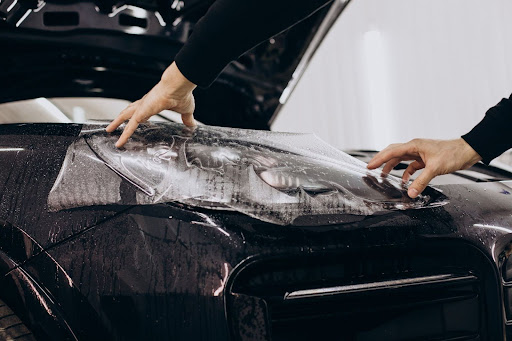Paint Protection Film (PPF) is designed to protect your vehicle from stone chips, scratches, and other potential damages. It's a formidable remedy against minor road hazards. However, its application can be tricky. Solar Screen shares with you, step by step, the process of applying PPF for a reliable and lasting result.
Preparation for PPF Film Application on Your Car
The preparation step is essential for a successful application. Do not neglect this mandatory phase to ensure the film applies correctly and without defects. To prepare your car, wash the bodywork thoroughly to remove all dirt, wax residues, and contaminants. Use a wax-free bodywork cleaner for this. At the end of the preparation, use a specific degreaser to eliminate any trace of grease, oil, or wax on the bodywork surface. Dry the bodywork with a clean and dry cloth before starting the PPF application.
PPF Film Application
Before starting to apply the film, choose a clean, dust-free environment. Also, avoid air currents that could lift and move the coating and interfere with your process. If possible, ask for assistance from another person for optimal results. To apply the film, gently remove the protective layer from the adhesive side, being careful not to leave fingerprints or dust. Then, spray soapy water directly onto the bodywork as well as on the adhesive side of your PPF.
Afterward, you can proceed to the positioning step. For this, place the film on the car's surface. Make sure to align the edges correctly. Note that the car protection coating remains quite manageable as long as it is wet. Take your time for a perfect result and do not hesitate to remoisten the surface if you need to reposition the film. Once the protection film is in place, use a plastic squeegee to eliminate excess water and air bubbles. The ideal technique is to start from the center and move towards the sides.

Drying
For proper adhesion to the bodywork, the shock-resistant film for cars needs drying time. Leave it for a few hours without using your vehicle, ideally in a dry place sheltered from the wind. Note that to ensure its protective function, the PPF hardens after application. It then forms a real shell for your car, protecting it from scratches, stone chips or gravel, minor impacts, and other shocks. It's a real second skin that helps preserve the aesthetic shine and value of your car. To reach the stage of complete hardening, it sometimes takes a few days. Avoid washing the car or exposing it to extreme conditions during the week following the PPF application.




